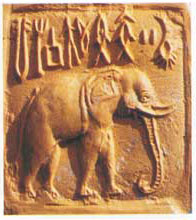
Harappan art: Dancing woman from Mohenjo Daro, in what is now Pakistan
Harappan art – the Bronze Age
By the Bronze Age, around 2000 BC, people in northern India were richer, because they were trading more with West Asia and Central Asia. They could afford to build cities. So they could afford to make more expensive art than their Stone Age ancestors at Mehrgahr.
Stone Age Mehrgahr
Who were the Harappans?
Harappan architecture
All our India articles

Harappan pottery from the Indus Valley, about 2000 BC
Harappan artists made bronze statuettes (little statues) like this dancing woman. She’s totally Indian. She’s way more of an independent person than any women in West Asian art at this time. Look how she holds her arms, with her hand on her hip.
What is bronze?
Harappan pottery
Harappan artists also made pottery decorated with painted rows of flowers and animals, like West Asian pottery. And they carved small stone statues, too.
History of pottery
Egyptian pottery
Mesopotamian pottery project
Harappan seals

Harappan seal ca. 2000 BC
Harappan people also carved seals for people to use to mark things they owned or had signed off on. So that people wouldn’t be able to copy your seal too easily, some of these seals had animals carved on them, like this Indian elephant. Many of the seals had writing on them too, but we can’t read the signs.
What are seals and sealings?
A project with clay seals
Animals of ancient India

Indian sealing
Did you find out what you wanted to know about Bronze Age Harappan art in India? Let us know in the comments!
Learn by doing: go see Indian art in a museum
More about Ancient Indian art
Bibliography and further reading about Indian art
Eyewitness India, by Manini Chatterjee (2002). Easy reading. It’s not specifically about Indian art, but you’ll find information about Indian art in this book.
Ancient India, by Virginia Schomp (2005). Written for teens. Again, not specifically about Indian art, but very good for reports, and there is information about Indian art.
Indian Art (Oxford History of Art), by Partha Mitter (2001). A good survey of Indian art for ordinary people, going from ancient India to modern India.
Indian Art, by Vidya Dehejia (1997). Also written for adults. The author’s the curator of Indian art at the Smithsonian Institution. She emphasizes the close relationship between Indian art and religion.